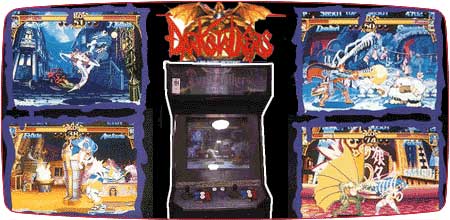DarkStalkers series

Retro Coin Op Synopsis
“Arise and show your fangs!”
One-on-one fighting games went Gothic in 1994 with the release of Capcom’s Dark Stalkers. Featuring legendary monsters from across the globe, the game brought a touch of the macabre to an already dark genre. Not surprisingly, the kids ate it up like blood from a young wench’s neck.
There was the usual backstory about monsters rising from the grave to compete in a tournament, but as always, nobody much cared about the story once the fighting began. The DarkStalkers lineup offered matchups of all the classic monsters—Romanian vampire Demitri Maximoff, English werewolf Jon Talbain, Egyptian mummy Anakaris, Canadian bigfoot Sasquatch, American catwoman Felicia, Brazilian merman Rikuo, German Frankenstein’s monster Victor Von Gerdenheim, cursed Japanese samurai Bishamon, Scottish succubus Morrigan Aensland and Australian rock and roll zombie Lord Raptor. Not only did the various beasties hail from several spots around the world, they also spanned the course of history from 2664 B.C. (Anakaris) to 1967 A.D. (Felicia).
Capcom had been honing its fighting game chops since its pioneering Street Fighter II in 1991, and DarkStalkers showed what three years of technological advancements could do. Gameplay basics hadn’t changed much—characters still fought to win two of three rounds, utilizing punches, kicks, combos and special moves—but the characters, backgrounds and sounds were light years ahead of Capcom’s earlier hit. When these monsters executed their special moves, spectacular animations filled the screen—Lord Raptor’s Evil Scream, Anakaris’ Pharaoh Magic, Victor’s Thunder Break, Morrigan’s Darkness Illusion and many, many more.
In addition to the enhanced graphics and sound, DarkStalkers added a few gaming bells and whistles to lure gamers away from other fighters. Most notably, DarkStalkers included a “special” meter, which filled up a little bit each time an attack was executed. Once the bar was filled, the characters’ attacks did extra damage, and super-powerful special moves could be executed. Other gameplaying changes allowed characters to block in mid-air, to throw multiple airborne attacks and to string moves together, along with a few other enhancements.
The new look and new features caught on quickly in the video gaming community, and DarkStalkers turned into another franchise title for Capcom. Two animated series were produced (one Japanese, one American), and a handful of arcade and home game sequels were released to the hungry public. Night Warriors: DarkStalkers’ Revenge added four more playable characters to the mix (including first game bosses Huitzil and Pyron), and Vampire Savior: The Lord of Vampire (sic) added even more. The latter game even dispensed with the traditional three-round system, giving characters multiple “life markers” within a single round instead.
Two more DarkStalkers sequels were released in Japan, but neither was imported to U.S. arcades (though they did come to home consoles). The lack of a full DarkStalkers lineup didn’t dampen any enthusiasm in U.S. arcades, however. The combination of street fighting and soul-stealing monsters was more than any red-blooded gamer could ask for, and DarkStalkers delivered with a wicked wink and a smile.
Arcade Machine Release History
1994 - DarkStalkers1995 - Night Warriors: DarkStalkers' Revenge
1997 - Vampire Savior: The Lord of Vampire
